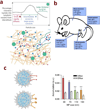Control of polymeric nanoparticle size to improve therapeutic delivery
- PMID: 26450667
- PMCID: PMC4656075
- DOI: 10.1016/j.jconrel.2015.10.006
Control of polymeric nanoparticle size to improve therapeutic delivery
Abstract
As nanoparticle (NP)-mediated drug delivery research continues to expand, understanding parameters that govern NP interactions with the biological environment becomes paramount. The principles identified from the study of these parameters can be used to engineer new NPs, impart unique functionalities, identify novel utilities, and improve the clinical translation of NP formulations. One key design parameter is NP size. New methods have been developed to produce NPs with increased control of NP size between 10 and 200nm, a size range most relevant to physical and biochemical targeting through both intravascular and site-specific deliveries. Three notable techniques best suited for generating polymeric NPs with narrow size distributions are highlighted in this review: self-assembly, microfluidics-based preparation, and flash nanoprecipitation. Furthermore, the effect of NP size on the biological fate and transport properties at the molecular scale (protein-NP interactions) and the tissue and systemic scale (convective and diffusive transport of NPs) are analyzed here. These analyses underscore the importance of NP size control in considering clinical translation and assessment of therapeutic outcomes of NP delivery vehicles.
Keywords: Drug delivery; Nanomedicine; Polymeric nanoparticles; Size control.
Copyright © 2015 Elsevier B.V. All rights reserved.
Figures




References
Publication types
MeSH terms
Substances
Grants and funding
LinkOut - more resources
Full Text Sources
Other Literature Sources
Research Materials
Miscellaneous

